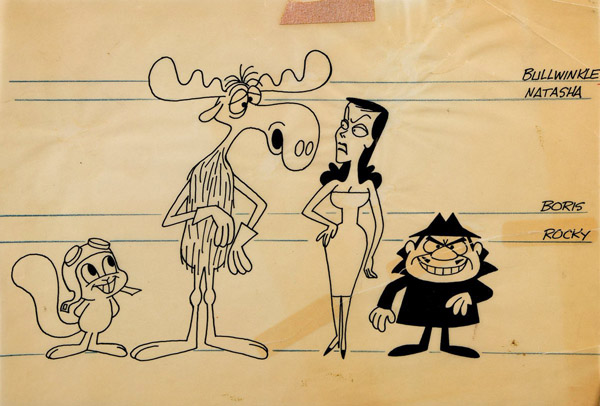
The Spies Report #6
For this edition of my interview series, I spoke with Skip Craig. Skip is a living legend. Skip started his career with Spike Jones and then worked for UPA. Skip’s best work, though, is during his tenure at Jay Ward, where he worked from the pilot of Rocky and His Friends until the closing of the studio. His son Jeff who retired just a week before this interview, also joined the conversation. This was by far the most exciting interview I ever did.
During this interview, I also helped my friend Amber Jones in the UK by talking to Skip about Bill Scott. Amber is making a fan documentary on Scott and is using terrific material, including rare archival audio interviews and footage of Bill Scott, June Foray, and Bill Hurtz. Part of this interview with Skip Craig is also in her doc. Her documentary also includes contemporary Mark Evanier, Corey Burton, Bob Kurtz, Frank Welker, Keith Scott, and Bill’s daughter Barbara. She is doing a great job, and I highly recommend you watch it once it is completed. If you don’t already have it, you should also go to Amazon and buy Keith Scott’s book The Moose that Roared. This book gives an extensive lookback at Skip’s career at Jay Ward Productions and is a book any animation fan must own.
Kamden Spies: Skip, I know you began with Spike Jones. How did you end up working with Spike Jones?
Skip Craig: In high school (Grad June 1949), I was a Spike Jones fanatic. I collected his records and went to the show whenever it was in the area. In March of 1950, they had a cancellation in Chicago and came to Minneapolis every day for two weeks. So, I went down the first night and then hung around and went to every show. The local human interest columnist on the Minneapolis Tribune got ahold of me for an interview. I said it in that “if I could just get to sit in with the band, that would be incredible.” Once in a while, the band would use guest celebrities. Dick Tracy’s Chester Gould was one. They gave him a funny suit and a prop horn and sat him in the back row to fake play for a show. Later, he reciprocated and Spike and the entire band were in the strip for a couple of weeks.
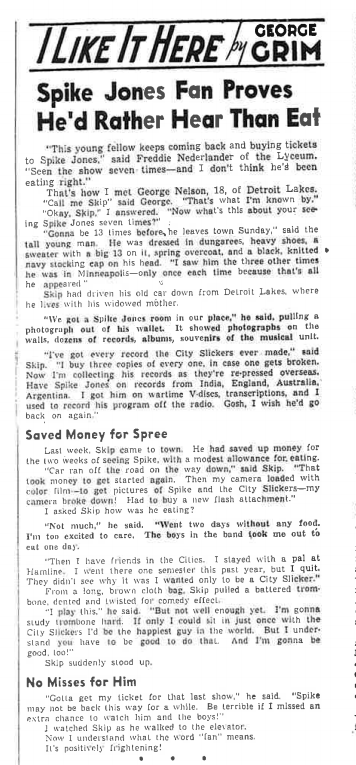
THE ARTICLE THAT GOT SKIP THE JOB. Skip was mistaken for George Nelson rather than George Craig. We’re not entirely sure why.
A couple of nights later, Spike sent his valet out in the audience and took me back to his dressing room, pointed at me, and said, “You’re in the show Sunday afternoon and evening.” So that’s how I got acquainted with Spike and the guys in the band. That was March 26, 1950. So a couple of months later, I had my horn painted and a slicker suit made. A lady at Penny’s put that together for me. I also had a derby. On May 30th, I met the train in Fargo (the show traveled in two Pullmans and a baggage car) and Spike seemed to dig it and again said “You’re in the show tonight.” My now wife was in college across the river, and got to see me play. I got to know both Joe Siracusa and Joe Colvin (trombone) well, and corresponded that summer with both. Three weeks after that show, the Korean War started and I knew where I’d end up – and I did, thanks to the draft. So when Colvin said in a letter, “Maybe you should come out.”, I knew it was now or never!
 I had been working at Swift’s locally and saved up a few hundred bucks, and in the fall of 1950, I headed to Hollywood. Joe Colvin got me a room in a boarding house he used to be in. I had the sleeping porch for five bucks a week. I would take the red-car to Beverly Hills and hang around the office. There I would chase coffee and hang around. Spike had me come in one evening where they were planning the record of Tennessee Waltz and I Haven’t Been Home in Three Whole Nights, and to chase coffee for everybody. Spike tore a five-dollar bill in half, and said, “come back tomorrow, and I’ll give you the rest of it.” I then said, “I would’ve paid you just to be here.” I got to go to the RCA recording studio to see them record Tennessee Waltz and Three Whole Nights and chase coffee for them. One other highlight was the Santa Claus Lane Parade of Stars. The band marched in their ‘union’ suits, long john’s, derbies, and ear muffs, playing Christmas songs. I went down to inflate balloons, and ended up marching down Hollywood Blvd. with the bass drum on my back steering Dick Morgan who couldn’t see where he was going. Now so we’re getting towards Christmas of 1950, and I went home. They called me and said, “You’re hired. The tour leaves January 6th.” I had a great year and a half selling programs, working wardrobe, did bits in the audience, and once in a while, I’d just sit in the back row. As a band boy, I also packed and unpacked the instrument case, worked wardrobe, hung and repacked wardrobe case, shined button shoes, set up and struck Spike’s drums, and dipped Juggler Bill Kings’ torches and head pieces while he was on. But along the third tour, I heard from the draft board. I got my physical in Milwaukee while on tour and had to quit the summer of ‘52. I went home and would soon end up in Korea, just like I knew I would. So that’s my story with Spike. I was just a complete fanatic about anything Spike Jones. I loved that Slicker sound. In fact, he designated me in an autograph as the no. 1 City Slicker Fan.
I had been working at Swift’s locally and saved up a few hundred bucks, and in the fall of 1950, I headed to Hollywood. Joe Colvin got me a room in a boarding house he used to be in. I had the sleeping porch for five bucks a week. I would take the red-car to Beverly Hills and hang around the office. There I would chase coffee and hang around. Spike had me come in one evening where they were planning the record of Tennessee Waltz and I Haven’t Been Home in Three Whole Nights, and to chase coffee for everybody. Spike tore a five-dollar bill in half, and said, “come back tomorrow, and I’ll give you the rest of it.” I then said, “I would’ve paid you just to be here.” I got to go to the RCA recording studio to see them record Tennessee Waltz and Three Whole Nights and chase coffee for them. One other highlight was the Santa Claus Lane Parade of Stars. The band marched in their ‘union’ suits, long john’s, derbies, and ear muffs, playing Christmas songs. I went down to inflate balloons, and ended up marching down Hollywood Blvd. with the bass drum on my back steering Dick Morgan who couldn’t see where he was going. Now so we’re getting towards Christmas of 1950, and I went home. They called me and said, “You’re hired. The tour leaves January 6th.” I had a great year and a half selling programs, working wardrobe, did bits in the audience, and once in a while, I’d just sit in the back row. As a band boy, I also packed and unpacked the instrument case, worked wardrobe, hung and repacked wardrobe case, shined button shoes, set up and struck Spike’s drums, and dipped Juggler Bill Kings’ torches and head pieces while he was on. But along the third tour, I heard from the draft board. I got my physical in Milwaukee while on tour and had to quit the summer of ‘52. I went home and would soon end up in Korea, just like I knew I would. So that’s my story with Spike. I was just a complete fanatic about anything Spike Jones. I loved that Slicker sound. In fact, he designated me in an autograph as the no. 1 City Slicker Fan.
KS: And you didn’t do anything involving track readings or like anything you did later in your career correct?
SC: No I never did anything like that
JC: It was Joe Siracusa though that brought you out to Hollywood to work, right? Joe was Spike’s drummer, and he said to my dad to come out to Hollywood and become a film editor.
SC: While I was in the Army, I withdrew my savings. Joe Siracusa started a Pizza place called “Meatball Manor”. He had called when I was in basic and asked for money. So I reluctantly gave him the money while I was in the Army. Of course, the shop didn’t make it. But by the time I got back, he was head film editor at UPA. He always had an interest in drawing and art. My wife and I got married as soon as I got home. We got married October 10th, 1954. So in a few weeks it will be 66 years and we are still healthy and lucid. We started going together on February 1st 1945, so next year that will be 76 years. So I guess it’s going to last! She was teaching in Minneapolis, and I went to a broadcasting school called the American Institute of the Air. As I finished, they were sending audition tapes around, and I thought I’d do some sports work for a local radio station. So as I was in the midst of all that, my wife was finishing her second year of teaching. We didn’t know what we were going to do. And then, all of a sudden, Joe calls asking if I want to be a film editor. I thought it was some choice! I would either be in some small Midwestern town or go to Hollywood. Of course, We chose Hollywood and soon got a job in the cutting room at UPA.
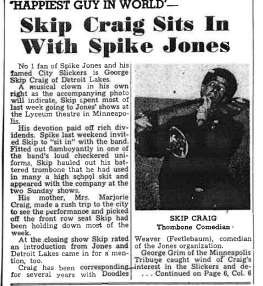 KS: Around what year would this be when you got into UPA?
KS: Around what year would this be when you got into UPA?
SC: it was September of 55, and they were about to start the CBS Gerald McBoing Boing Show. That was how Joe got me in. Suddenly, the studio had to expand to create all of the short little segments for that show.
KS: That show didn’t last long, though.
SC: Yeah, it flopped.
KS: Do you have any memories of Steve Bosustow?
SC: Bosustow, as you know, was the main guy. He didn’t really come down and mix with everybody.
KS: How about Pete Burness?
SC: Oh, Pete was a great guy, and he later also turned up at Jay Ward, where he did some commercials and such. Probably the nicest man I ever met. On my last year at UPA, we had the only three Oscar nominations. Pete got to accept for the Magoo he directed.
 JC: Didn’t you continue to freelance track reading throughout your time at Jay Ward at other studios?
JC: Didn’t you continue to freelance track reading throughout your time at Jay Ward at other studios?
SC: Probably the first time I did any freelancing was for Jay. When he came to town and did his pilot in 58 with a couple of artists at UPA. Sam Clayberger and Roy Morita. They were not animators, but, they did the Rocky & His Friends pilot. First, they asked me to read the track for them. After that, Jay had me add the sound effects and work with him to dub it. So I did that, and then the following year he was trying to sell. Once he sold it in the Summer of 59, I was doing a lot of work for him. Then you (to Jeff) were born in September of 59. Less than a month later, after Jeff was born, Jay opened his own studio, and I went there. Years later, Rog and I did a ton of freelancing reading including the Charlie Brown movies and series. Also Roger Ramjet and much more. I also read commercials in many languages, phonetically, the way they sounded.
JC: Oh, wow.
SC: Oh, and by the way, since Joe Siracusa was head of the cutting room at UPA, he gradually got the room packed with Roger Donley, Spike’s tuba player, himself, me, and Earl Bennett (Sir Frederic Gas). He was the comedian with the wild hair and played a gnarled old tree branch. The bow was another long slim branch with two leaves at the end. It made the sound of a violin, playing on a small sanded leather reed in his mouth which he called his Sadavariess. He and Freddy Morgan were the stars after Doodles left after my first tour. It was the four of us at UPA before it broke up.
About the time that I was going to go off with Jay, Saperstein came in and bought UPA. We all left then. Earl went over to HB. Joe Siracusa went with Herb Klynn, who started Format Films. Roger came with me to Jay Ward. But unfortunately, after the first four shows, they packed it off to Mexico, and Jay had to let Rog go. But he came back about three or four different times for various periods of time like when we were doing George of the Jungle and when we did Fractured Flickers and when we did some of the live-action Laurel and Hardy and Buster Keaton stuff. So he was back periodically. And Joe came in when we did the Buster Keaton’s The General, and he did the music recording and editing. Roger ended up at Melendez, doing the Charlie Browns.
KS: When they used the silent clips on Fractured Flickers, did Jay care whether the films were PD or not?
SC: Oh yeah, those films would have been long in the public domain. Jay found this shady collector named Raymond Rohauer. He had a huge stock of old films. By then, the copyrights were pretty well run out. Jay borrowed films from his collection, and the writers would decide what film part they’d use and then I’d get them blown up to 35mm.
KS: What was it like working with Jay?
SC: It was fun! Jay had season tickets to everything so I saw lots of Lakers, Dodgers, UCLA Basketball etc. But he paid very badly.
JC: And No pension
SC: It was still fun. Even the eulogies at Jay’s funeral were funny, which were all about how much fun he was to work for even with lousy pay.

Jay Ward and Skip Craig
JC: I remember coming over to Jay’s and seeing it as this fun factory. I remember Jay being the funny guy in the front room to the right with this handlebar mustache. And then Bill Scott was to the left. And then there was you by yourself as the film editing department. And then Jay got on his exercising kick and put a gym in, and you won the free trip to Hawaii.
KS: Wait, wait, hold on. Skip you won a free trip to Hawaii from Jay Ward?
SC: When Jay decided that he was going to have a mustache, he had a contest where everybody had to grow a mustache, but I didn’t. Everybody got a little portable TV at the end of that but not me. But I wasn’t about to try and grow a mustache. Jay made the contest as a gimmick to give himself an excuse to grow the mustache.
JC: I remember Jay got on a soda fountain kick and put a whole soda fountain in the studio. Then he got on his health kick and put the gym in the building. Dad, I remember you being obsessed with winning that trip.
KS: But how did you win the trip?
SC: He picked out a lucky mile number and sealed it in an envelope, and it was in the secretary’s desk drawer. When he opened it up, I won it.
JC: You won by logging in what miles you were riding the bike in the gym. I think you rode more than anybody else.
SC: Yeah, it was a first-class trip for one to Hawaii for a weekend, so I asked if I can take the value of that and add to that to make it a week for 3.
JC: Wait, it was only for a weekend?
SC: Well, we eventually made the adjustments so I could bring Helen and Jeff and spend more than a week there.
JC: I remember that we went to Big Island for a day and Maui for at least a couple.
KS: So, how was the studio set up? Where were you in the studio?
SC: It was an old house, and I was in the next to the back bedroom. When I first got there, Jay was three or four doors down the street in an apartment house called the Andalusia. That was his headquarters for him and for Bill and all the writing. And then almost on the corner of Sunset and Havenhurst was this old three-bedroom house. There were a couple of background people in there like Adrian Diamond.
KS: So you weren’t even in the same building as Jay and Bill when Rocky & His Friends was being produced?
SC: No. They hung out in that apartment building. Much later on when he acquired 8218 Sunset, he had an office there and Bill worked more from home, or front room in the house I was in.
KS: How often did Jay come to check on you guys?
SC: Oh, he was strolling around all the time. He was always holding a diet 7-Up in his hand, and I saw him quite a lot. After every recording session, he’d come and bring me the dialogue. He’d tell me the cuts that he wanted to make.
KS: Did you ever get to go to the recording sessions?
SC: No, I never got to. That was Jay’s domain. He guarded that territory so nobody could be there but him. He loved being the dialogue director. But later on, when Keith Scott did his book, Bill let Keith monitor all the original session tapes. All I ever got was the select take, without pickups on 35 mag, but Keith heard the sessions complete. I guess Frees was always acting out and being disruptive. Keith told me one-time Bill Conrad was on the floor laughing uncontrollably saying ‘Get that SOB out of here, I’ll kill him.”
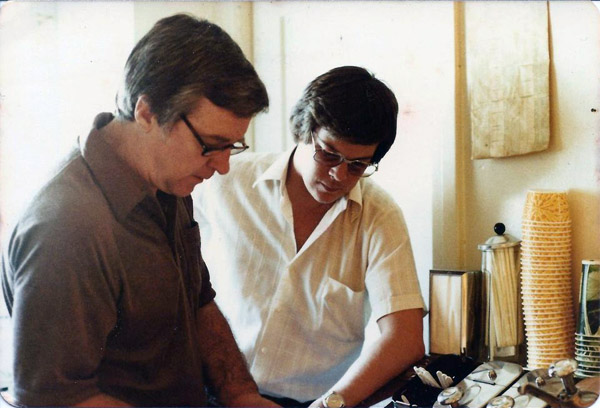
Skip Craig (left) and Keith Scott (right)
KS: Skip, were you at all involved in Jay’s scheme to get Statehood for Mooselvania?
JC: I remember you being sent to Minnesota to buy an island.
SC: Yeah, that was in the midst of that Operation Loudmouth publicity campaign. Jay came around one day and said, “you’re going to Minnesota to buy an island.” I said okay because you never knew if he was serious or not because he was so quirky. He said then “I’m gonna give you a signed blank check, so don’t get across the Canadian border and keep going.” Publicity man, Howard Brandy, was dressed as Dudley Do-Right, and he was dressed like Napoleon. He bought this Panel Truck, and he got Sam Clayberger to create this paper mache art decorations for it. They made it into a campaign truck with a bandwagon and a blasting loud speaker on top. They went across the country and had these Statehood for Mooselvania parties and signings of petitions. The truck worked its way around the country with Jay getting kicked out of several towns as nuisances because of Jay always blaring his music and driving up and down the main street. They got a big bunch of signed petitions and ended up at the white house gate.
In the meantime, I was up in Minnesota and the Lake of the Woods. I come from a little town called Detroit Lakes, and I got my uncle, who was a retired mailman there and had also done some surveying. We took off and drove to the Canadian border. He knew enough to go into the courthouse and look at all the plots and maps. It turned out that there were hundreds of islands on the Canadian side and like five or seven on the American side. We ended up finding one guy who was a dentist in one of the towns up there. He was a hip guy and saw the fun in it. He said, “I’m not gonna sell it because I am building a little fishing shack out there, but I’ll lease it to you to use for publicity purposes.” So I got a three-year lease on the thing. We then flew out to Mooselvania in an old one engine plane with pontoons.
 When we got to the island, the pilot said “boy, I hope the weather doesn’t blow up, I’ve gotten stuck out here.” But he kept circling and going over the mainland for a while so he could find a moose to show us. He finally found one and said, “there, there’s Bullwinkle.” We spent a little time out there, and the island was small. I don’t think it was more than three acres. It had a swampy section and a hilly section. We look a lot of pictures. Jay loved it when we all got back.
When we got to the island, the pilot said “boy, I hope the weather doesn’t blow up, I’ve gotten stuck out here.” But he kept circling and going over the mainland for a while so he could find a moose to show us. He finally found one and said, “there, there’s Bullwinkle.” We spent a little time out there, and the island was small. I don’t think it was more than three acres. It had a swampy section and a hilly section. We look a lot of pictures. Jay loved it when we all got back.
In the meantime, Howard and Jay cruising the country, getting these petitions signed. They had quite a pile of them. Then when they get to Washington DC, they drive up to the gate to the White House. The guard at the gate has his hand on his gun and tells Jay to get out of here. Howard is cowering in the back hiding. And Jay says, “Well, he doesn’t have to be rude.” This was the day of the very height of the Cuban Missile Crisis, and here are these two nuts at the gate demanding to see the president to present their statehood petitions. This is another example of Jay’s great timing.
KS: Was it harder for you to edit the live-action stuff like the Laurel and Hardy, Fractured Flickers, and Buster Keaton than it was with Rocky and Bullwinkle or George of the Jungle?
SC: Oh, sure. When you shoot an animated cartoon, you slate it at the start of each scene and just time them together. The live-action stuff like the Laurel and Hardy and Buster Keaton specials were quite complex to do.
KS: Do you have any memories of working on The Nut House?
SC: Well, The Nut House was very much like Laugh-In. in fact, it preceded it. It was a bunch of young comedians with wild sketches and stuff. It was mostly live-action. There were some animated bits though. They had a hostess that was a beauty queen named Kathy Kersh. They dubbed her the nut girl and dressed her up with this big squirrel tail and outfit, which was obviously a take-off on the Playboy Bunnies. I thought the show was maybe better than Laugh-In. It premiered at a bad time, though. Its taping date was the day of Kennedy’s funeral. Needless to say, the audience was not in a jocular mood. Another Jay Ward timing mishap.
KS: By that time, were you just track reading?
SC: Yes, in fact, I mostly did track reading on Rocky and Bullwinkle because it all went to Mexico. I did do the editing on George, Super Chicken, and Tom Slick, though. I did get to do all of the Dudley Do-Rights and a few of the best fairy tales.
JC: I was always really impressed by dad’s little rolls of sound effects that Jay would ask for a sound, and you would get to decide how to make it. That was impressive for me as a kid.
KS: What made them decide to close the studio?
SC: Well at the end, all we were doing were those Cap’n Crunch commercials. Jay asked Bill if he wanted to keep doing this, and Bill said it was no fun anymore. So it all ended in August of ’84 and I spent 25 years there.
KS: And I guess that’s when you went to Disney?
SC: Yeah. In 1984-1985, I freelanced a lot at a place called DIC. Then Robert Birchard called and asked if I wanted to do some freelance for Disney because they were starting their own TV department, where I worked until I was 80. It sure went quickly it seemed, but it had turned into 27 years, and ended in August 2012. 50, total 57 years in animation editing, mostly track reading. At Disney, I was only track reading because editing had gone digital and required a whole retraining from the Moviola days.
Special thanks to Joe Siracusa, Laura Craig, Mark Arnold, and Keith Scott
All photos from Skip’s career at Jay Ward courtesy of Keith Scott
All other photos are courtesy of Jeff, Helen, and Skip Craig.


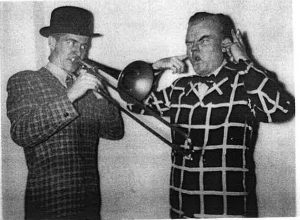

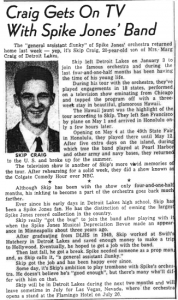
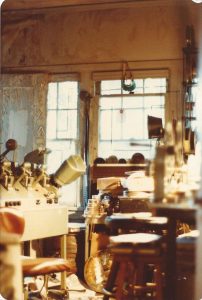
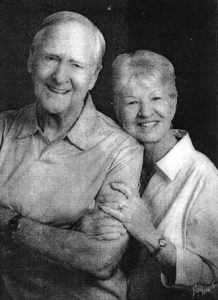
 Kamden Spies is an animation fan, collector, and aficionado. He received his undergraduate degree in an IDM in film history and creative writing from the University of Alabama at Birmingham and is currently getting his Master’s in Library and Information Sciences at Indiana University Bloomington.
Kamden Spies is an animation fan, collector, and aficionado. He received his undergraduate degree in an IDM in film history and creative writing from the University of Alabama at Birmingham and is currently getting his Master’s in Library and Information Sciences at Indiana University Bloomington.

















































It’s interesting to see how a fan’s obsession led to such a remarkable career!
The reason Skip and the other City Slickers wore derby hats was so they could use them as mutes. By holding the derby in front of the bell of the trumpet or trombone, you could create a nice “wah-wah” effect with less distortion than you would get by using a stem mute or plunger (think of Charlie Brown’s teacher). It wasn’t just because the derbies looked cool, although they did. Nowadays you can buy felt-lined plastic derby mutes that never wear out, but you’d look pretty silly with one of those on your head.
Kathy Kersh was indeed a beauty queen, Miss Rheingold 1962 (the beer, that is, not the opera). After guest starring on “Ben Casey”, she married star Vince Edwards; then, after guest starring on Batman, she married Burt Ward. A gorgeous young lady back in the day, but she hasn’t done any acting in many years.
Great interview, Kamden, and so nice that Skip, a very nice man and one of the real worker bee behind-the-scenes people who was integral to actually “putting cartoons together” for completion, finally gets this latter-day recognition. Skip was the most helpful person I met in my early visits to Hollywood when I was nineteen going on twenty, and it was the encouragement from Skip that gave me the confidence to try and crack American voice-work all the way from Australia. Thanks also for hooking me up with Jeff on Facebook. If I can be of assistance in your further researches let me know.
I had no idea Jay Ward lasted all the way to 1984! Also, I don’t think anyone today would have the guts to do a stunt like the Statehood for Moosylvania drive. Ward would probably have a field day with social media.
Great slice of history!
Nice to put a face to a name that appeared so constantly for years. Nicer still that he’s a mensch and the business was pretty good to him.
Being an outsider to all this talk on working for Jay Ward, I was intrigued about so many little bits and pieces. I would have loved to hear more about the sound effects and how they were created. Some of those sound effects were used for Warner Brothers and MGM cartoons of that same period, along with other early TV cartoons. On a related note, I often wondered whether Jay Ward and Total Television artists bumped into each other since the same animation studio was used. In fact, there were some cases where similar looking characters showed up in both Jay Ward and Total Television cartoons. I have the Keith Scott book; maybe one day, I’ll be able to read it somehow with some sort of text-to-speech technology.
What a fun read. Thanks to my brother-in-law Jeff, for sharing the early days of those new and crazy ways to get a job.
Your dad has had a wonderful and not-the-norm lifestyle.
As a big Laurel and Hardy fan, with parents who appreciated Spike Jones, it was a good way to grow up..
Here’s to the characters who made the Hollywood Characters come alive to the world.
This was a terrific piece; great anecdotes and stories. Thanks.
Loved reading Skip’s story. He and my dad (from Detroit Lakes,MN) are good friends. I’ve heard quite a bit of this before, but fun seeing it in print. Hi, Skip! From Jill Mattson
Thank you so much for this wonderful interview, Kamden. Skip sounds like a wonderful guy. I’ve been to Detroit Lakes — many of my relatives lived in nearby Gary, Minnesota.
Great article/interview with lots of new information. We all have our own personal memories of watching Rocky and Bullwinkle. I was at UCLA when the studio (and original Bullwinkle statue) was on Sunset Blvd. I would often visit the little house behind the Emporium to watch the work going on. The door was always open (literally). I’ve spent the last 40+ decades trying to locate the stock footage crashes that were featured in the George of the Jungle credits. (Finally found a 16mm copy of the original of that footage on eBay – it actually came from Warner’s short). Thanks for the memories!